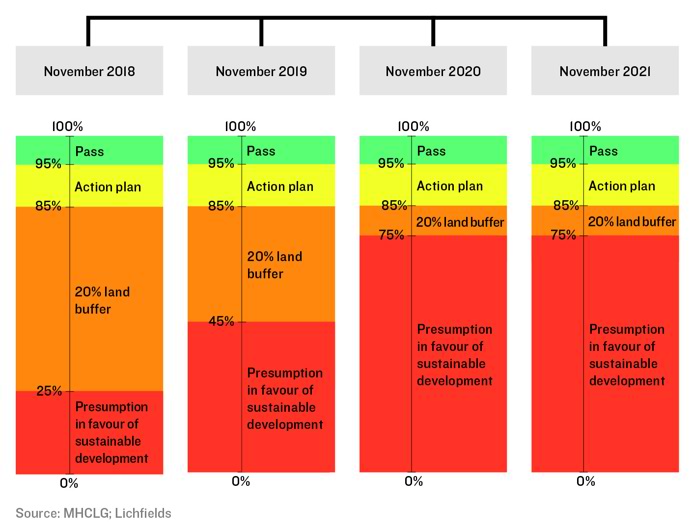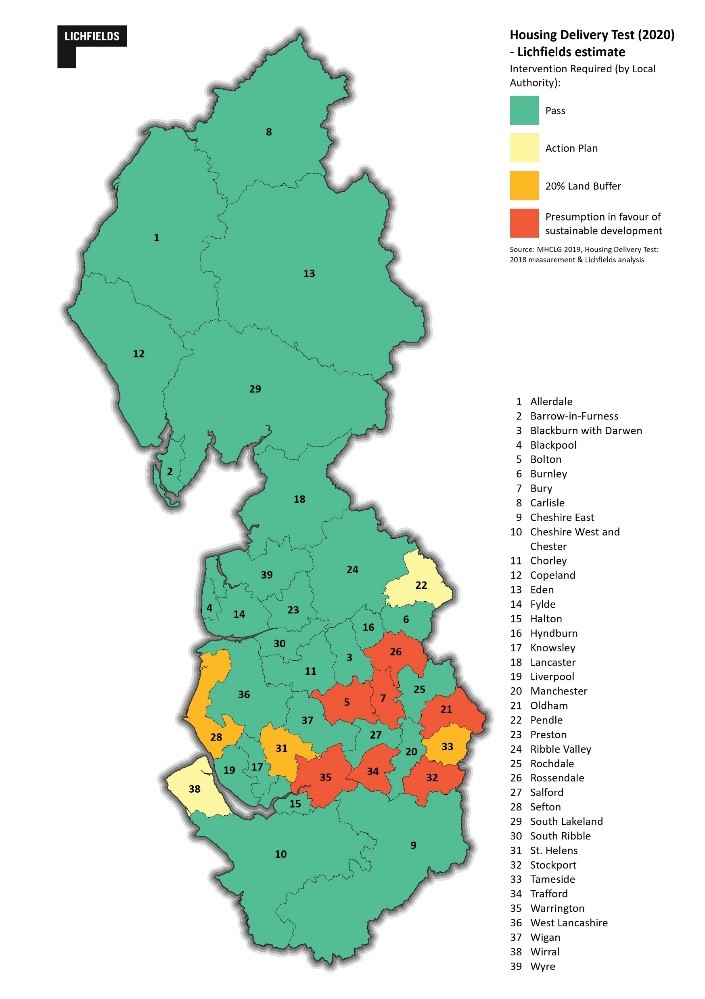In February, the Ministry of Housing, Communities and Local Government [MHCLG] published the results of the new Housing Delivery Test [HDT] for each local authority in England. The new test marks a clear shift in the Government’s thinking regarding delivery and providing a straightforward and reasonably transparent approach to determining whether Councils are hitting their targets. Crucially, it also has real ‘teeth’, with the HDT effectively changing the route to the presumption in favour of sustainable development, triggering paragraph 11 of the Framework.
Whilst many of us are familiar with the previous approach which looked at the 5-year housing land supply, the HDT now requires us to see how successfully Councils have been at delivering their housing requirements over the past 3 years, with a series of graded ‘penalties’ depending on the extent of the shortfall, with a 3-year transition period (see Figure 1 below). Whilst the objectives and methodology of the HDT are now well known, it is helpful to consider the implications of these results and to assess how the situation might change as the thresholds for the various sanctions increase, firstly in November 2019 and again in November 2020.

The picture in 2019
What does this mean in reality? Looking nationally, applying the results of the HDT from February 2019 (delayed from November 2018) shows that:
- 7% of all councils will be required to produce an action plan;
- 27% of councils will need to apply a 20% buffer to their housing land supply;
- 66% of councils will be required to take no action at all; and,
- crucially, no councils will immediately be subject to the presumption in favour of sustainable development.
As shown in Figure 2, looking more specifically in the N0rth West region:
- 26 councils will not be required to take any action at all; and,
- 13 councils will need to apply a 20% buffer to their housing land supply and prepare an action plan.
The results therefore indicate that the North West region is generally performing well when compared to the national results, highlighting a relatively higher level of housing delivery over the past 3 years (at least when compared with Local Plan housing targets / household projections).
The picture in 2020
If we make certain assumptions regarding housing delivery continuing along a similar trajectory over the next 2 years and trend forward the housing need calculations, we can start to provide an indication of which authorities may be vulnerable to failing the test once the threshold is revised to 75% in November 2020. Our work suggests that in 18 months’ time, around a third of all English councils could face the presumption in favour unless delivery rates begin to increase.
As shown in Figure 3, our analysis suggests that within the North West region:
- 27 councils may be required to take no action at all;
- 2 councils may be required to produce an action plan;
- 3 councils may need to apply a 20% buffer to their housing land supply; and,
- 7 councils could be subject to the presumption in favour for sustainable development (Bolton, Bury, Oldham, Rossendale, Stockport, Trafford, and Warrington).
It is clear from analysis that the Greater Manchester authorities are particularly struggling, with 6 out of 10 authorities requiring some form of intervention and 5 subject to the most severe level of HDT penalty. This is likely to place increasing pressure for the GMSF to be adopted as soon as possible and to start bringing forward more housing sites earlier in the plan period. Elsewhere, there are potential HDT-compliance issues in Wirral and Sefton on Merseyside, and parts of East Lancashire. Otherwise, the situation is largely positive for the rest of Lancashire, Cumbria, and Cheshire. This could of course change significantly if housing delivery falls, or conversely if higher housing targets or future household projections results in less attainable housing requirements.

Going forward: The influence of the standard methodology
In February 2019, the standard methodology for assessing Local Housing Need [LHN] was introduced. The simplified methodology is based solely on the 2014 household projections, with most Local Authorities having a percentage uplift to address (un)affordability. A number of regions, especially Greater London and the South East, have faced an increase in housing requirement as a consequence. For the purposes of assessing performance against the HDT, an increase in the future requirement means that it is not just the increasingly severe threshold for the application of sanctions that will cause authorities to fall into the presumption in favour of sustainable development categories.
Whilst in the North West the standard methodology has reduced the LHN for many authorities, there still remains uncertainty regarding future projections and therefore the future approach. Questions surrounding the full impact of future housing requirements therefore remain.
Results reveal that 680,000 homes were built over the last three years; that’s an average of c.227,000 per year. There is clearly a long way to go in order to reach the Government’s aim of 300,000 homes in order to address the housing crisis. This highlights the key weakness of the HDT: it is only effective if housing targets are ‘right’ in the first place.
Although we cannot know how many houses will be delivered in the future and can therefore only estimate future performance against the HDT, this analysis is nevertheless instructive in highlighting those authorities where a significant increase in net completions is likely to be necessary going forwards if the most severe sanctions are to be avoided.
Furthermore, the fact that the HDT brings more certainty in relation to the application of a 20% buffer is also likely to have an impact on the other route to the “tilted balance”, which relates to five-year housing land supply. In the context of the tougher approach to deliverability within the National Planning Policy Framework [Framework], this will require more sites to be identified for future development in a number of authorities. For more information on the approach to the assessment of five-year housing land supply set out in the Framework, take a look at our Insight Focus.
In conclusion, the HDT is a key monitoring tool based on previous housing delivery performance. However, the numbers produced are likely to change as the Test will reflect future fluctuations in the data and housing figures, and it will be difficult to precisely estimate housing requirements many years into the future. These estimates show that continuing to monitor changes to housing figures is essential to ensure future housing projections are sufficient and can be met.
To find out more about the HDT and LHN please follow the link below to our Insight focus.






